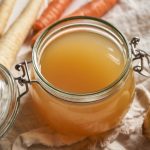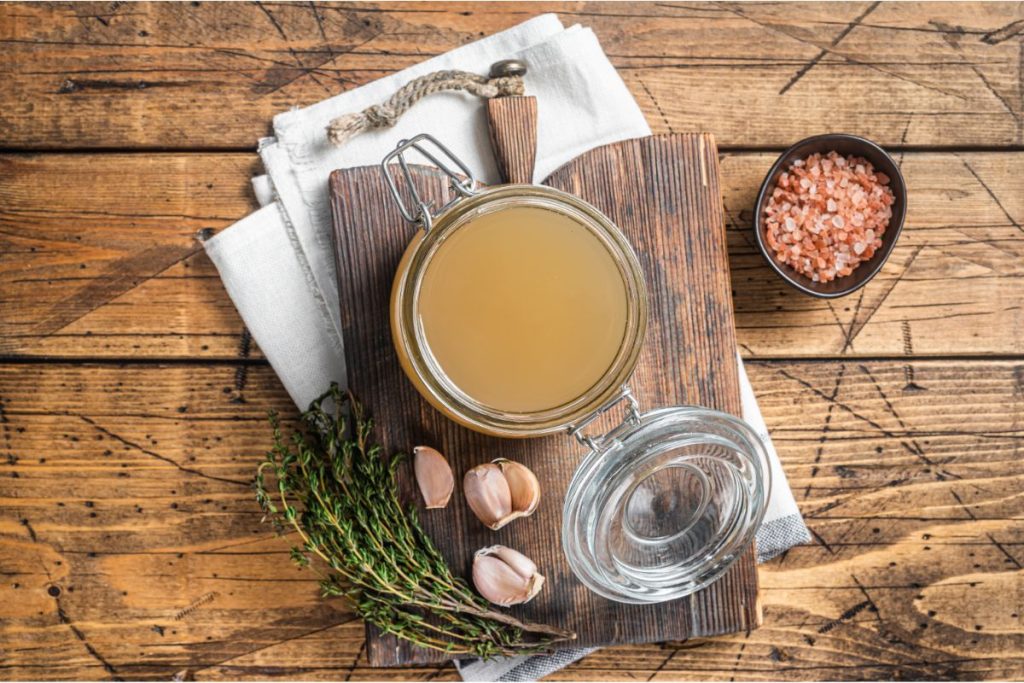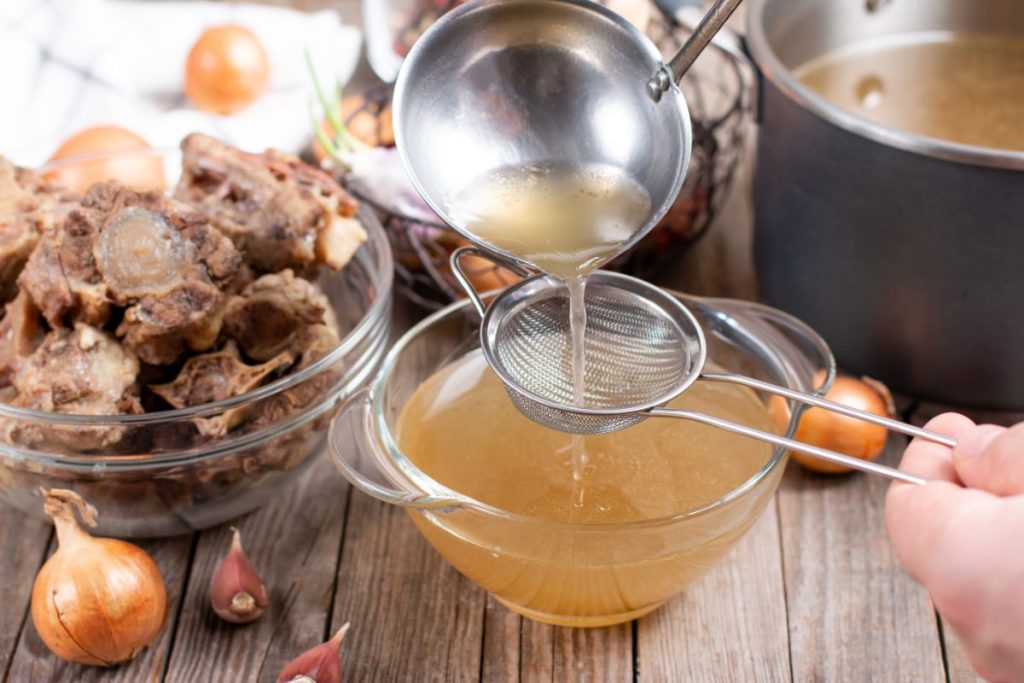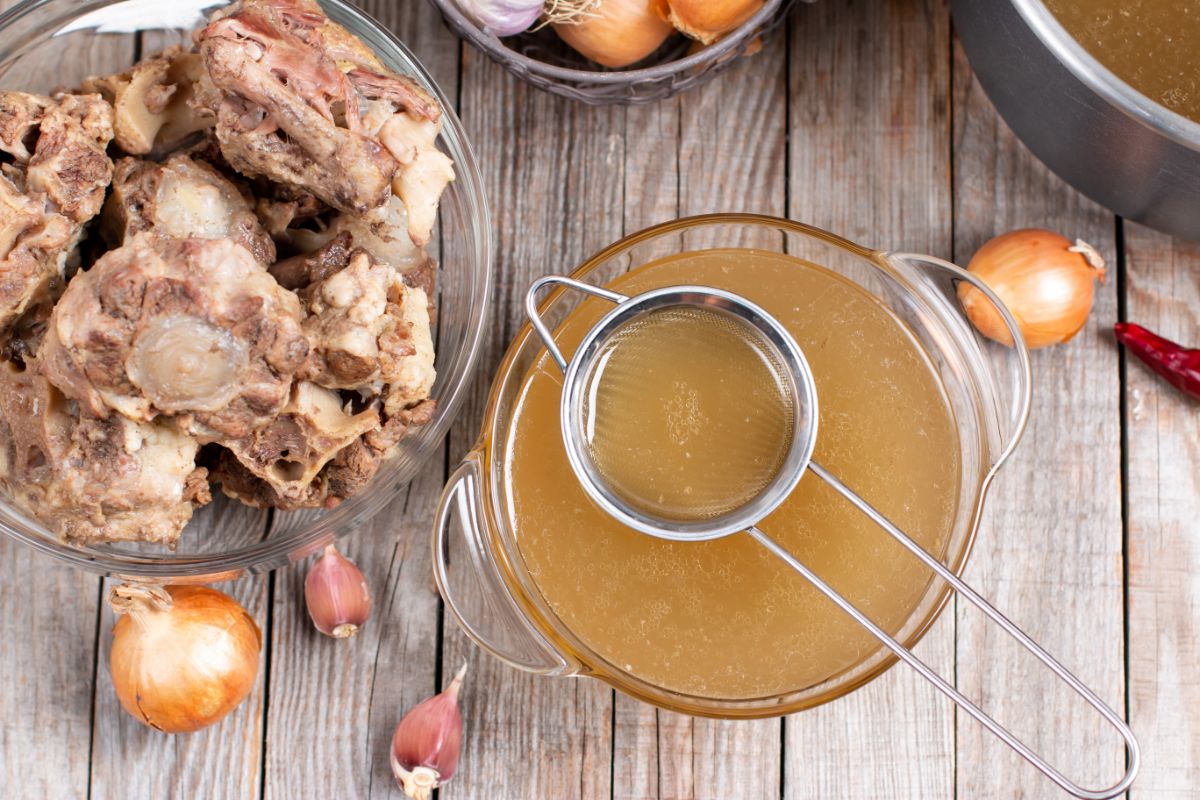To pressure can beef broth, prepare the broth by simmering beef bones, meat, vegetables, and seasonings. Strain and transfer the broth to sterilized canning jars, leaving an inch of headspace. Use a pressure canner to process the jars for 20-25 minutes per altitude.
Is it Better to Water Bath Can or Pressure Can Beef Broth?
It is best to pressure-can beef broth. Water bath canning is only safe for high-acid foods like fruits, vegetables, and pickles. Beef broth is low-acid, so it must be pressure canned to kill harmful bacteria.
Here are some reasons to pressure can beef broth:
- Low-acid ingredients must be processed at 240 to 250 degrees Fahrenheit, a temperature range only achievable in a pressure canner.
- Beef broth has a shelf life of up to 1 year, while beef broth that is water bath canned has a 2-week shelf life.
- Pressure canning beef broth takes about 1 hour, while water bath canning can take up to 3 hours.

Beef Broth Canning Recipe
- Total Time: 7 hours, 45 minutes
- Yield: 7 pints 1x
Description
Follow this step-by-step recipe for a rich and flavorful beef broth is a rich and flavorful that adds depth to soups, stews, and sauces. Made with high-quality ingredients and preserved to perfection, this recipe ensures high-quality results.
Ingredients
- 6 pounds beef stock bones
- 2 medium onions, quartered
- 4 medium carrots, diced
- 3 bay leaves
- 3 sticks of celery, diced
- 1 cup warm water
- 3 cloves of garlic
- 1 teaspoon of dried thyme
- 3 to 4 sprigs of fresh parsley
- 8 to 10 whole peppercorns
- 1 teaspoon of dried oregano
- Apple cider vinegar (5%)
- Cold water
- Salt and pepper to taste
Instructions
- Preheat oven to 450°F. Bake the soup bones in a large roasting pan uncovered for 30 minutes.
- Add carrots, celery, and onions. Bake for 30 minutes and drain fat.
- Transfer the bones and vegetables using a slotted spoon to a large stockpot, instant pot, or Dutch oven.
- Add warm water to the roasting pan; use a wooden spoon to loosen any meat residue stuck in the pan.
- Transfer pan juice into the pot.
- Add herbs and seasonings and cover with cold water.
- Bring the mixture to a boil over medium-high heat (about 30 minutes).
- Sterilize your canning jars, lids, and rings. Use your dishwasher’s sterilization cycle or boiling water and dish soap for the jars. Wash the canning lids and rings in warm, soapy water.
- Reduce heat on the broth and simmer uncovered for 4-5 hours, skimming off any foam. Add water to keep ingredients submerged, if necessary.
- Remove large beef bones and chunks of meat from the broth using tongs.
- Strain the remaining broth through a cheesecloth-lined colander.
- Let it stand for a few minutes, and discard any meat, vegetables, or seasonings that have gathered on the cloth.
- Skim all the fat off and discard as it can affect the jar sealing inside the canner.
- Put 2-3 inches of water into the pressure canner and place it over low heat.
- Pour the broth into the canning jars using a funnel, leaving 1-inch headspace.
- Use a spatula or bubble remover to remove air bubbles inside the jars.
- Add the lids and rings and tighten until fingertip-tight.
- Transfer the jars to the pressure canner using canning tongs, leaving space between the jars and the edges of the canner. Process pints for 20 minutes and quarts for 25 minutes per elevation and canner type:
Dial-Gauge Pressure Canner
- 0 – 2,000ft: 11 lbs
- 2,001 – 4,000ft: 12 lbs
- 4,001 – 6,000ft: 13 lbs
- 6,001ft and up: 14 lbs
Weighted Gauge Pressure Canner
- 0 – 1,000ft: 10 lbs
- 1,001ft and up: 15 lbs
Post Processing
- When the time is up, allow the pressure canner to depressurize naturally before using tongs or a jar lifter to transfer the jars carefully onto a clean, cushioned surface to cool at room temperature for 12-24 hours.
- Remove the screw bands from the jars and check the seals by ensuring the center of each lid does not flex when you press on it. If any seem loose or fail the flex test, transfer those jars to the refrigerator and consume them within a week.
- For all properly sealed jars, label the jars with the canning date and contents and store them in a cool, dry place away from direct sunlight.
Notes
When selecting beef bones, you may use marrow bones, veal bones, neck bones, oxtails, shank bones, or knucklebones.
- Prep Time: 20 minutes
- Canning Time: 25 minutes
- Cook Time: 7 hours
Nutrition
- Serving Size: 240g
- Calories: 17kcal
- Sugar: 0g
- Sodium: 893mg
- Fat: 0.5g
- Saturated Fat: 0.3g
- Carbohydrates: 0.1g
- Fiber: 0g
- Protein: 2.7g
- Cholesterol: 0mg
How to Add Flavor When Canning Beef Broth
You can do a few things to add flavor to beef broth when canning it.
- Add vegetables. Vegetables add flavor and nutrients to broth. Popular choices are onions, carrots, celery, and garlic.
- Season with herbs and spices. Herbs and spices can add a lot of flavor to broth. Some good herbs and spices include thyme, rosemary, bay leaves, and black pepper.
- Use beef bones instead of stock cubes. Beef bones are a great source of collagen and gelatin, giving broth rich flavor and texture. When you simmer beef bones in water, the collagen and gelatin break down and dissolve into the broth, giving it a deep, beefy flavor.

What Size Jars Should Be Used for Canning Beef Broth?
Pint jars are the best size for canning beef broth. They are the easiest to find and the most convenient to fill and process in a pressure canner. Quart-sized jars can also be used for canning beef broth but take up more space in the pressure canner. Quart jars also take longer to process in the pressure canner than pint jars.
Do You Have to Strain the Fat When Canning Beef Broth?
When canning beef broth, strain out excess fat but retain the collagen and gelatin-rich components. While a certain amount of fat can add flavor to the broth, too much fat can lead to issues during canning and affect the quality of the preserved broth. Excess fat can interfere with the sealing process and increase the risk of spoilage.
To strike a balance, skim off any visible excess fat or impurities that have risen to the surface during cooking. Use a fat separator or ladle to skim off as much fat as possible before straining the broth.

How Long Does it Take to Can Beef Broth?
Whether you use a weighted-gauge pressure canner or a dial-gauge pressure canner, you must adjust the processing time and pressure according to the altitude where you live. The time it takes to can beef broth depends on the size of the jars you use and the type of pressure canner you have.
- Pint jars take 20 minutes to process in a pressure canner at 10 PSI.
- Quart jars take 25 minutes to process in a pressure canner at 10 PSI.
What are the Benefits of Canning Beef Broth?
- Convenience: Canned beef broth allows you to have homemade broth on hand for up to a year.
- Control over sodium: You can adjust the salt level or opt for low-sodium options in the broth, making it suitable for individuals with specific dietary requirements.
- Cost-saving: Canned beef broth can save you money in the long run because buying store-bought broth can be expensive, especially if you use it often.
- Eco-friendly: Canned beef broth is stored in plastic and is more environmentally friendly than the plastic packaging of store-bought broth.
- Flavor: Canned beef broth has a richer flavor than store-bought broth.
How to Store Canned Beef Broth
Follow these tips to store your broth and ensure the broth has the maximum shelf life:
- Label the jars with the canning date to keep track of the shelf life.
- Store the jars of canned broth between 50°F and 70°F.
- Store the jars in a location that is out of direct sunlight.
- Store the jars upright to prevent lids from warping.
What is the Shelf Life for Canned Beef Broth?
The shelf life of properly canned and stored beef broth is 1 to 2 years. However, it’s important to note that the quality and flavor may gradually diminish over time. Consuming the beef broth within the first year is best to ensure optimal taste and nutritional value.
The “best used by” date on canned beef broth will depend on when it was processed and the specific guidelines provided by the canning recipe or resource you followed. It is recommended to label each jar with the date of canning and use the oldest jars first, following a first-in, first-out approach.

